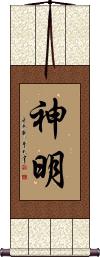Many custom options...
And formats...

Not what you want?
Try other similar-meaning words, fewer words, or just one word.
Feel free to email me with your request. If it's easy, I'll translate it for free and add it to this database of calligraphy for you.
Deities Gods in Chinese / Japanese...
Buy a Deities Gods calligraphy wall scroll here!
Personalize your custom “Deities Gods” project by clicking the button next to your favorite “Deities Gods” title below...
Deities / Gods
In Chinese, Japanese Kanji, and old Korean Hanja, 神明 title refers to deities or gods (can be the singular or plural form).
Depending on the context, this could also mean “divine.”
Specifically, in Japanese, this can refer to Amaterasu (as an enshrined deity).
In some Buddhist contexts, this also means deity but can also refer to “intelligence” (as in all-knowing).
Frightful Demon / Asura
This demon title comes from the ancient Sanskrit word Asura.
阿修羅 is often used in Buddhism when describing various demons. Sometimes defined as “Fighting and battling a giant demon.”
In the context of Buddhism: This title originally meant a spirit, spirits, or even the gods (perhaps before 1700 years ago). It now generally indicates titanic demons, enemies of the gods, with whom, especially Indra, they wage constant war. They are defined as “not devas,” “ugly,” and “without wine.” There are four classes of asuras, separated according to their manner of rebirth. They can be egg-born, womb-born, transformation-born, and spawn- or water-born. Their abode is in the ocean, north of Sumeru but certain of the weaker dwell in a western mountain cave. They have realms, rulers, and palaces, as have the devas.
In terms of power, Asuras rank above humans but below most other deities. They live near the coastal foot of Mount Sumeru (on the northern side). Their domain is partially or wholly in the ocean.
Not the results for deities gods that you were looking for?
Below are some entries from our dictionary that may match your deities gods search...
| Characters If shown, 2nd row is Simp. Chinese |
Pronunciation Romanization |
Simple Dictionary Definition |
神明 see styles |
shén míng shen2 ming2 shen ming jinmei / jinme じんめい |
More info & calligraphy: Deities / Gods(1) deity; god; (2) (See 天照大神) Amaterasu (as an enshrined deity); (surname) Jinmei The spirits of heaven and earth, the gods; also the intelligent or spiritual nature. |
地祇 see styles |
dì qí di4 qi2 ti ch`i ti chi jigi ちぎ |
earth spirit gods of the land; earthly deities earth deity |
地神 see styles |
dì shén di4 shen2 ti shen jigami ぢがみ |
gods of the land; earthly deities; (surname) Jigami The earth devī, Pṛthivī also styled 堅牢 firm and secure; cf. 地天. |
火神 see styles |
huǒ shén huo3 shen2 huo shen honoka ほのか |
god of fire (female given name) Honoka The gods of fire, stated as numbering forty-four in the Vedic pantheon, with Mahābrahmā as the first; of these the Vairocana sutra takes twelve, i. e. 大因陀羅; 行滿; 摩嚕多; 盧醯多; 沒口栗拏; 忿怒; 闍吒羅; 吃灑耶; 意生; 羯攞微; (11th unknown); 謨賀那. Cf. 火尊; 火天. |
諸天 诸天 see styles |
zhū tiān zhu1 tian1 chu t`ien chu tien shoten しょてん |
{Buddh} various deities; the gods All the devas. |
七福神 see styles |
shichifukujin しちふくじん |
Seven Gods of Fortune; Seven Deities of Good Luck; Seven Lucky Gods |
八十神 see styles |
yasogami やそがみ |
(archaism) many gods; many deities; many kami; (surname) Yasogami |
国つ神 see styles |
kunitsukami くにつかみ |
gods of the land; earthly deities |
国津神 see styles |
kunitsukami くにつかみ |
gods of the land; earthly deities |
十六善神 see styles |
shí liù shàn shén shi2 liu4 shan4 shen2 shih liu shan shen jūrokuzenshin |
Two lists are given, one of sixteen 大將 mahārājas; another of sixteen 善神 good spirits or gods; all of them are guardians of the good and enemies of evil. |
八百万の神 see styles |
yaoyorozukami やおよろずかみ |
(exp,n) {Shinto} (See 八百万・やおよろず) all the gods and goddesses; all the deities; (person) Yaoyorozu no Kami |
十忿怒明王 see styles |
shí fèn nù míng wáng shi2 fen4 nu4 ming2 wang2 shih fen nu ming wang jūfunnumyōō |
The ten irate rājas, or protectors, whose huge images with many heads and limbs are seen in temples; perhaps the ten krodha gods of the Tibetans (Khro-bo); their names are 焰鬘得迦 Yamāntaka; 無能勝 Ajita; 鉢納 鬘得迦 ? Padmāhtaka; 尾覲那得迦 Vighnāntaka; 不動尊 Acala; 吒枳 ? Dākinī; 儞羅難拏 ? Nīladaṇḍa; 大力, 送婆 Sambara; and縛日羅播多羅 Vīrabhadra. |
Variations: |
kunitsukami; chigi(地祇) くにつかみ; ちぎ(地祇) |
gods of the land; earthly deities |
Variations: |
yaoyorozunokami やおよろずのかみ |
(exp,n) {Shinto} (See 八百万・やおよろず) all the gods and goddesses; all the deities |
The following table may be helpful for those studying Chinese or Japanese...
| Title | Characters | Romaji (Romanized Japanese) | Various forms of Romanized Chinese | |
| Deities Gods | 神明 | jin myou / jinmyou / jin myo | shén míng shen2 ming2 shen ming shenming | |
| Frightful Demon Asura | 阿修羅 阿修罗 | ashura | ē xiū luó e1 xiu1 luo2 e xiu luo exiuluo | o hsiu lo ohsiulo |
| In some entries above you will see that characters have different versions above and below a line. In these cases, the characters above the line are Traditional Chinese, while the ones below are Simplified Chinese. | ||||
Successful Chinese Character and Japanese Kanji calligraphy searches within the last few hours...





